Key Points:
- Study examines sustained-release vs enteral nimodipine in subarachnoid hemorrhage
- Sustained-release version safe, well-tolerated up to 800 mg and linked to better outcome
An experimental intraventricular sustained-release formulation of nimodipine, known as EG-1962, may offer similar or even greater benefits than standard nimodipine without the risk of hypotension for patients with aneurysmal subarachnoid hemorrhage. Results of a phase I/IIa dose-escalation study were published online December 8, 2016, ahead of print in Stroke.
“Our hypothesis was that we need a more local approach to increase the cerebral concentration and decrease the systemic concentration of nimodipine to avoid side effects,” explained lead author Daniel Hänggi, MD, of the University Medical Center Mannheim (Mannheim, Germany), in a telephone interview with Neurovascular Exchange.
EG-162 (Edge Therapeutics) is a slow release formulation of nimodipine in which microparticles of the drug are contained in a biodegradable polymer suspended in hyaluronic acid. It is delivered via a single administration over the external ventricular drain and releases nimodipine into the subarachnoid space for at least 21 days.
For the current study, the NEWTON (Nimodipine Microparticles to Enhance Recovery While Reducing Toxicity After Subarachnoid Hemorrhage) investigators randomized patients with aneurysmal subarachnoid hemorrhage treated with coiling or clipping to treatment with EG-162 (n = 54) or enteral nimodipine. All patients were World Federation of Neurological Surgeons grade 2 to 4 and had been fitted with an external ventricular drain.
The open label trial divided patients into 6 dose-level cohorts: 9 patients per cohort received 100 to 1,200 mg EG-1962 and 3 patients per cohort received enteral nimodipine.
The maximum tolerated dose of EG-162 was 800 mg. One serious adverse event related to EG-1962 occurred in a patient taking the 400 mg dose (allergic reaction), and 2 EG-1962 dose-limiting toxicities (increased intracranial pressure) occurred without clinical sequelae. There were no incidences of hypotension related to use of EG-1962, compared with 3 cases that occurred among the 18 patients (17%) taking enteral nimodipine.
Favorable outcome, defined as a score of 6-8 at 90 days on the extended Glasgow Outcome Scale, occurred more frequently among patients who received EG-1962 at any dose, compared with those who received enteral nimodipine (table 1).
Table 1. 90-Day Extended Glasgow Outcome Scale Score 6-8
|
100 mg EG-1962 |
200 mg EG-1962 |
400 mg EG-1962 |
600 mg EG-1962 |
800 mg EG-1962 |
Enteral Nimodipine |
|
56% |
67% |
78% |
44% |
56% |
28% |
Overall, the likelihood of unfavorable outcome was lower with the use of EG-1962 than with enteral nimodipine. Use of EG-1962 was also associated with reduced delayed cerebral ischemia (31% vs 61%) and need for rescue therapy (24% vs 56%).
Better Therapies Needed
“Evidence-based treatment for patients suffering from aneurysmal subarachnoid hemorrhage is very limited,” said Dr. Hänggi. “Nimodipine is widely used, but its effects are limited by side effects such as hypotension. So, there is a really a need for additional treatment.”
Now that this study has identified a maximum tolerated dose of 800 mg and established a good tolerability and safety profile, the investigators have moved on to a prospective phase III trial. This trial, which has already begun in the US, Canada, Finland, and Israel, is comparing the 90-day clinical outcomes of EG-162 with those of standard nimodipine therapy. Results are expected to be available in mid-2018.
Source:
Hänggi D, Etminan N, Aldrich F, et al. Randomized, open-label, phase 1/2a study to determine the maximum tolerated dose of intraventricular sustained release nimodipine for subarachnoid hemorrhage (NEWTON [Nimodipine Microparticles to Enhance Recovery While Reducing Toxicity After Subarachnoid Hemorrhage]). Stroke. 2016;Epub ahead of print.
Disclosures:
- Dr. Hänggi reports receiving consulting fees from Edge Therapeutics.
- This study was funded by Edge Therapeutics.


